The Sony A7R V is the latest iteration of Sony’s high-resolution R series of A7 full-frame mirrorless models, aimed at landscape, commercial, fashion and architecture photographers.
While the full-frame BSI CMOS sensor appears to be the same 61.2 MP device as its predecessor, the Sony A7R V adopts two separate processors to expand its capabilities. In addition to the Bionz (XR) processor enabling a native sensitivity range of ISO 100-3,200, which can be expanded to ISO 50-102,400, there’s a second dedicated AF processor solely for AI-based subject recognition and capture for both stills and video.
Besides the 5th generation AF, several other upgrades are likely to filter through to others in the A7 series when their time comes. Expanded processing and new gyros for the image stabilization system mean Sony is claiming up to 8 stops of blur mitigation, up from 5.5 of the previous model. There’s also a swivel-type 3.2-in (2.1 M dot) touchscreen that will no doubt appeal to video users, while the inclusion of a cradle for tilting up and down is aimed at landscape photographers.
The viewfinder also gets an upgrade and boasts an impressive 0.9x magnification and an upgrade in resolution to 9.44 M dots. While not new to Sony exactly, the A7R V also features full-size lossless compressed RAW and the addition of medium and small-sized RAW options. With a 1/250 max flash sync and 10 fps continuous shooting (up to 8 fps with AE/AF with tracking in live view), the shutter is the same hybrid mechanical/electronic unit found on the A7R IV.
Although not really positioned as a filmmaker’s camera, the A7R V has impressive video specs. From a 7680×4320 cropped area, there’s 8K at 24/25p, as well as a 4K option at up to 60p. Plus, there’s the choice to capture oversampled 4K at up to 30p from the full-sensor width or from a Super35mm size crop.
Adopting a similar size body as its predecessor, the Sony A7R V body with card and battery weighs 723 g (1 lb 9.6 oz). Files are saved to two dual SD UHS-II/CFexpress type A card slots, while connectivity options include USB-C, Bluetooth (5.0) and Wi-Fi (802.11ac) 2×2 MIMO.
The Sony A7R V is available now for $3,899/€4,500 body only.
Key specifications
- 61.2 MP full-frame BSI CMOS sensor
- Native ISO 100-3,200, with expansion to ISO 50-102,400
- Twin processors (one dedicated to AF)
- 10 fps RAW continuous shooting (up to 8 fps with AE/AF with tracking in live view)
- 5-axis IBIS with up to 8-stop compensation
- 8K 24/25p and 4K/60p video from a 7680×4320 crop
- Full width 4K/30p (oversampled)
- 9.44 M dot OLED viewfinder (with 0.9x magnification)
- Fully-articulated 3.2-in (2.1 m-dot) touchscreen with tilt option
- Two card slots (dual SD UHS-II/CFexpress Type A)
Overall performance
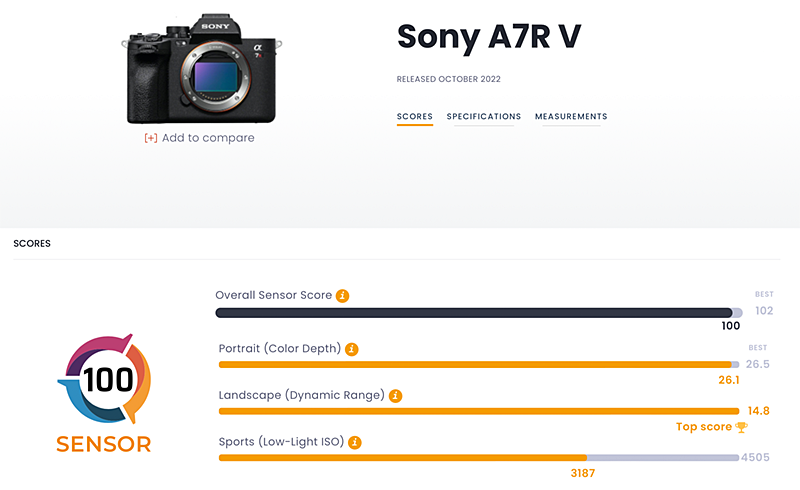 Click on the score chart above to open the Sony A7R V product page.
Click on the score chart above to open the Sony A7R V product page.
The 61.2 MP BSI CMOS sensor in the Sony A7R IV achieved a DXOMARK score of 100 and is one of the class-leading full-frame sensors in our lab tests. The high score places it in joint 3rd place overall alongside cameras such as the Leica M11, Nikon Z7 II and Panasonic Lumix S1R, and is just one point below the medium format (33 x 44mm) sensor in Pentax 645Z at 101 and two points below the Hasselblad X1D-50c.
The 61.2 MP sensor performs exceptionally well across the board, but it’s particularly impressive in dynamic range (Landscape score). The maximum 14.8 EVs measured at the Sony A7R V sensor’s base ISO (ISO 100) matches the best in our database. Maximum color depth is also impressive at 26.1 bits at ISO 100 but it is at the lower end of the range (26.0 – 26.4 bits) of those with a DXOMARK score of 100. Even though the Sony A7R V sensor has a high pixel count the full-frame BSI CMOS performs well in the low light ISO (Sports) score. With a computed value of 3187 ISO the 61.2 MP sensor is on par with the Panasonic Lumix S1R, and well ahead of the Nikon Z7 II; both lower pixel count models.
In-depth comparisons
As the Sony A7R V adopts the same or perhaps a related sensor to its predecessor the Sony A7R IV we’ve compared the two to see what, if any, differences there are between them. We’ve also compared the 61.2 MP sensor in the Sonys to a rival BSI CMOS-equipped camera, the 45.7 MP Nikon Z7 II. While cutting-edge at the time, the sensor is related to the one in the Nikon D850, introduced in 2017. The Nikon Z7 II sensor is ranked at a similar performance level in our database, as previously mentioned.
Portrait (color depth)
Perhaps unsurprisingly, both the Sony A7R V and A7R IV sensors show a very similar response throughout the sensitivity range. The 0.1-bit difference (26.1 vs 26.0 bits respectively) at base ISO is going in the right direction but it’s negligible all the same. Best at base ISO is the Nikon Z7 II sensor with a maximum response measured at 26.3 bits. However, the Z7 II has a lower pixel density and more importantly, a lower sensitivity with a lower native base setting of ISO 64 (measured at an even lower ISO 46). Technically, the +0.3-bit difference means the sensor is better at distinguishing colors but at that level, it is unlikely to be noticed.
All three models’ sensors are dual conversion gain types and all three share similar improvements, starting somewhere between the ISO 200-400 settings and continuing to influence the ISO 800 settings. Of the three, it is the Sony A7R V sensor that has the best response. However, the uplift is only in the region of +0.4-0.5 bits over the Nikon and 0.2-0.4 bits over its predecessor. Again, such small improvements are unlikely to be noticed. A third uplift in the response is noticed at ultra-high ISOs in the Sony A7R V, which mirrors the results of the Sony A7R IV without any evidence of smoothing visible in the latter’s results.
Landscape (dynamic range)
Dynamic range is one of the more tangible characteristics when discussing image quality, and modern sensors perform well and all have a wide dynamic range at base ISO. All three BSI CMOS sensors compared here have nearly 15 stops (14.7-14.8 EV) at their native base sensitivities, but the Sony A7R models have the same wide DR at ISO100 as the Nikon at ISO64, favoring the former. Closer examination reveals further differences when the high dual conversion gain is applied.
All three start high conversion gain between their ISO 200-400 settings but it is the Sony A7R IV that has a slight advantage over the others at ISO 200. With a gentle decline in DR from the base setting as ISO sensitivity increases, it differs from the obvious fall and rise in DR (at ISO 200 and ISO 400 respectively) seen in the Sony A7R V and Nikon Z7 II. However, the trade-off at ISO 200 with the Sony A7R V results in a slightly better response of around +0.3 EV at ISO 400, which is maintained against the Nikon doubling to 0.6 EV at ISO 25,600 and above. But, against its predecessor, the Sony A7R IV, it’s just +0.1EV ahead at those higher ISOs.
Sports (low-light ISO)
All three sensors handle noise well, but each has a slightly different result in our SNR 18% test. The Sony A7R V sensor has cleaner images in the ultra-high sensitivity range of ISO 3200 – 12800 over the other two sensors, and there’s always about a +1 dB advantage over the Nikon Z 7II. The exception is at their respective base sensitivity, where the Nikon is +0.5 dB higher. Nevertheless, the +1 dB advantage translates into nearly a +0.2 EV difference over the Nikon Z7 II at the 30 dB threshold, where we calculate the low-light ISO value.
Conclusion
As the latest iteration, the Sony A7R V has too many improvements to list here, but even looking at the headline features, the fifth-generation model with its new AF system and improved sensor shift is certainly a potent and hugely capable camera. The adoption of the same full-frame 61.2 MP BSI CMOS sensor as its predecessor however wasn’t entirely unexpected. While there are a few differences in the sensor output in terms of color depth and dynamic range at various ISO settings, the modifications are marginal. At $3,899/€ 4,500 body only, the price has crept upwards from the Sony A7R IV at launch, but that’s not unexpected in these turbulent times. As the most refined and accomplished in the series, the Sony A7R V model remains a compelling choice at this level.
In this review, we have mentioned the Sony A7R V’s most relevant rivals from other brands. As usual, you can compare it with these and with other models and create your own comparisons and in-depth analyses using our interactive image sensor ranking tool.


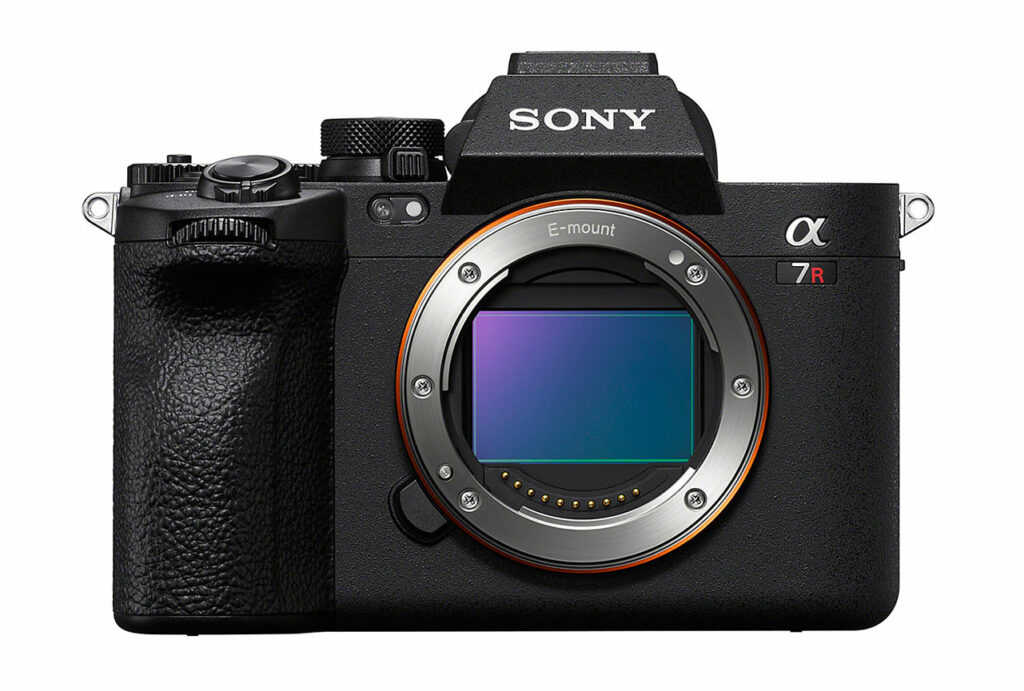


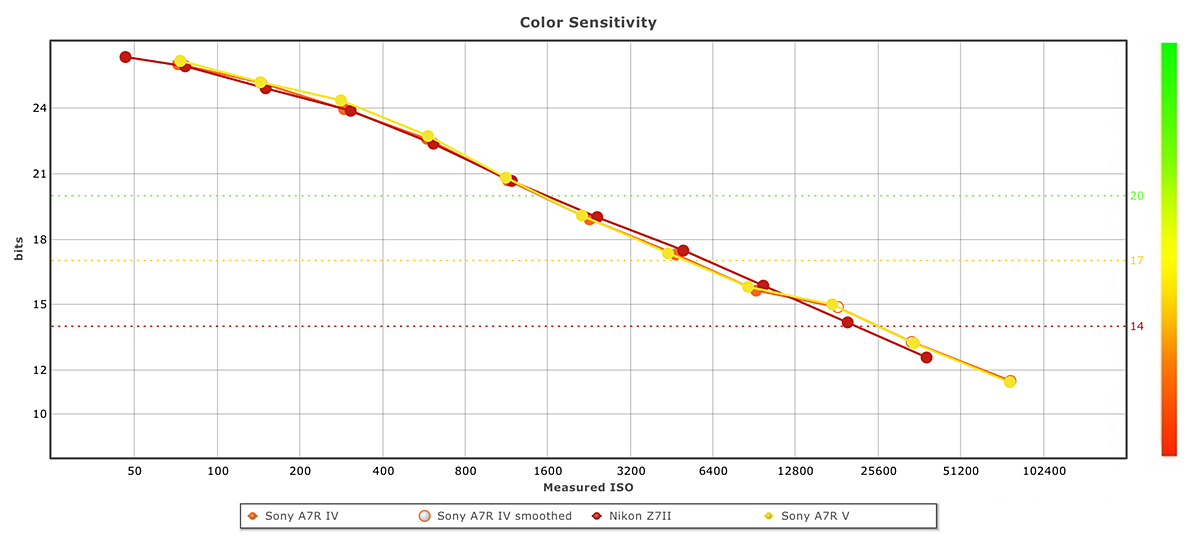
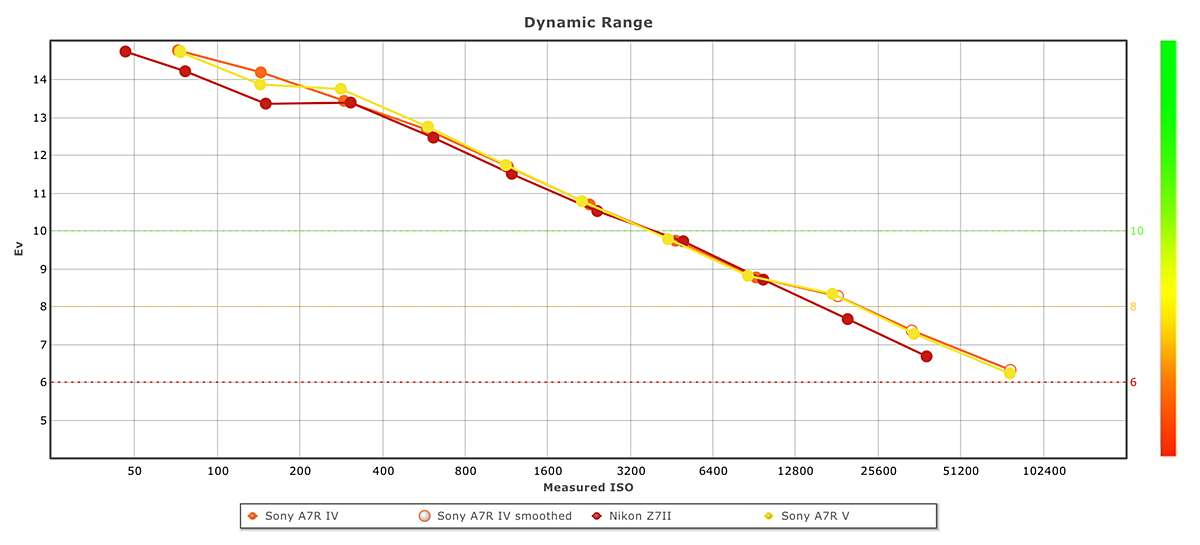
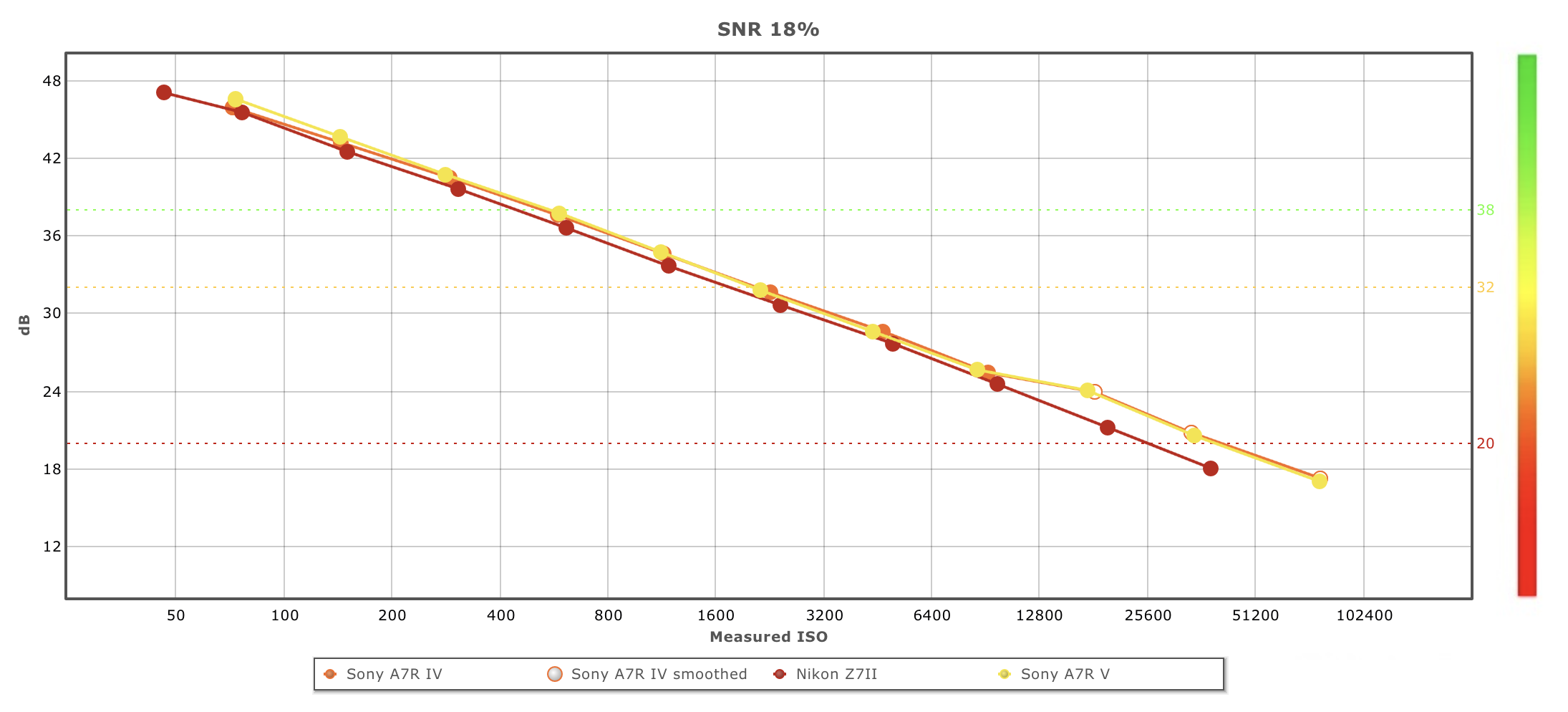
DXOMARK encourages its readers to share comments on the articles. To read or post comments, Disqus cookies are required. Change your Cookies Preferences and read more about our Comment Policy.